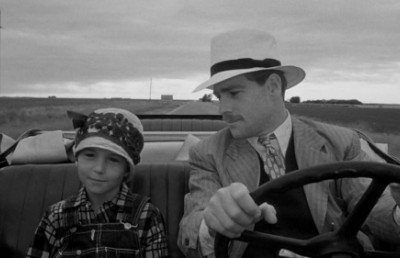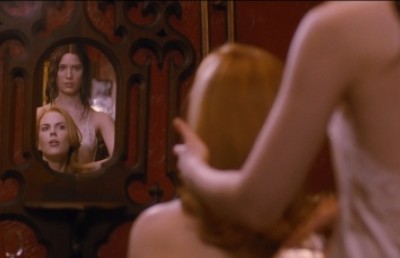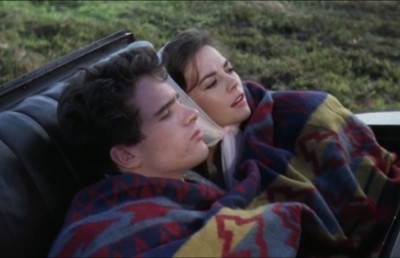The Last Taboo: Necrophilia in Kissed and Nekromantik

Seldom has any film ever satisfied Robin Wood’s assertion that “the release of sexuality in the horror film is always presented as perverted, monstrous, and excessive” 1 to quite the extent that Jörg Buttgereit’s Nekromantik (1987) does. This sordid piece of German cinema depicts the violence, depraved sex, and despair that take place in an urban environment caught in a state of acute decay. Robert Schmadtke (Daktari Lorenz) is a jaded young man who works for Joe’s Street Cleaning Agency, a company that retrieves corpses from accident sites. He lives in a dilapidated apartment with his girlfriend Betty (Beatrice M.), and he has the perverse habit of bringing his work home with him. Betty shares his morbid tastes, and they have decorated their home with a particularly grim sense of interior design. The shelves are lined with mason jars containing human organs. The walls are plastered with anatomical charts, photos of murderers, and posters of cadavers. There are even bone mobiles strung from the ceiling that recall Tobe Hooper’s The Texas Chain Saw Massacre (1974).
Things have become stale, so Robert makes off with a corpse and presents it to Betty as a surprise. Apparently a little dripping death is necessary to get the couple’s juices flowing again. The ensuing sexual depravity is so vile that Stanley Wiater, who ranks it tenth on his list of the most disturbing films of all time, suggests that Nekromantik “qualify as one of the most repulsive movies ever made.” 2 Given the subject matter at hand, this is hardly surprising, but it leads us to the question; is it even possible to have a tasteful look at necrophilia?
The best answer to that query might be the Canadian indie film Kissed (1996), which takes a decidedly less vile look at the same subject. In fact, when Matthew Hays of the Montreal Mirror asked if he’d seen the film, Jörg Buttgereit acknowledged the similarity, saying “Kissed is sort of the girlie version of my movie” (“Doing the Dead.” Montreal Mirror. 27 March 2009). While his specific choice of words may be politically incorrect, it does imply that Kissed comes from a substantially less masculine perspective. Based on the short story We So Seldom Look on Love by Barbara Gowdy, and directed by Lynne Stopkewich, Kissed tells the story of a female character, Sandra Larson (Molly Parker), from a female perspective. The film effectively documents the way that Sandra’s lifelong fascination with death leads her from the caring burial rituals she acts out as a child, to a job at a funeral home that affords her the opportunity to engage in a much more intimate relationship with death. She is aware of the taboo nature of her activities, but sees nothing morally wrong with them as her feelings and experiences have brought her to believe that everyone is unique and deserving of compassion, even when they are no longer alive.
Throughout the film, shots of Sandra’s reaction to the traditional ways of handling the deceased allow the viewer to glimpse her distaste for the callous way that flesh is considered inert and unfeeling. These moments contribute to the way that Kissed places the audience in position to relate to Sandra. It isn’t expected that we will share her obsessions, but she is a likable character that spectators will try to understand. It also doesn’t hurt that the film employs her memories of childhood as a back-story that provides some degree of motive, as well as making her compulsion to commit acts of necrophilia seem somewhat more natural.
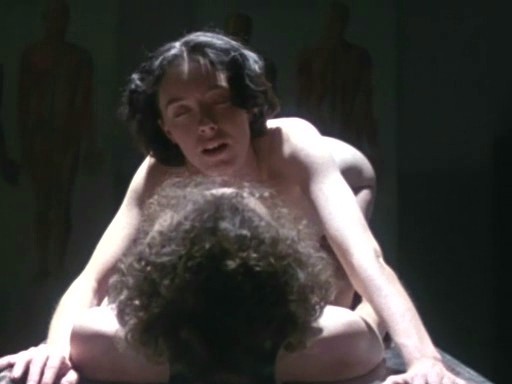
Nekromantik is an entirely different case. If Stopkewich’s film can be said to tell its tale from a subjective view point, then Buttgereit’s exploitative work is best described as coming from an abjective one. Robert and Betty are not interested in the spiritual elements of the act, nor are they particularly concerned with treating their inanimate partners with any sort of compassion. Betty may be shown snuggling up with her dead friend and reading books to him in bed, but when he’s not in use, he is hanging on the wall with a pair of plates at his feet to catch the blood dribbling from his congealed corpse.
One of the most obvious examples of this subjectivity/abjectivity is the way that animals are treated in the two films. The images of a pre-pubescent Sandra carefully wrapping toilet paper around the dead animals she finds, before committing them to the earth in moonlight ceremonies, portrays her as a caring person whose fascination with death stems from a deep respect for the last vestiges of life that she feels are still present in the flesh. Nekromantik employs scenes of animal cruelty, including the graphic killing and skinning of a rabbit, to more fully illustrate the perversions of its protagonist. While Robert is not the one seen killing the rabbit, the audience does bear witness to his complete disregard for animal welfare when he is shown brutally beating a cat to death after he discovers that Betty has abandoned him (and absconded with their ‘friend’). He snares the cat in a black garbage bag and beats it against the walls of his apartment, leaving bloody smears, before placing it on a rack in his bathroom so that he may indulge in a Bathory-esque soak in bloody bathwater.
It’s evident that Nekromantik is using these shock tactics to assault the viewer, but for what purpose? Christopher Sharett, writing about the apocalyptic aspects of The Texas Chain Saw Massacre, a film that influenced the decor of Robert Schmadtke’s apartment, suggests that “anthropophagy occurs in a period when a given society perceives its breakdown and finds a need to descend to an extreme level of experience through collective violence or sexual orgy.” 3 This quote refers specifically to cannibalism, an act that isn’t ever shown in Nekromantik, although the link to ‘collective violence or sexual orgy’ is quite appropriate. Given that Nekromantik was made in Berlin during the last years of a bifurcated Germany, it doesn’t seem that far-fetched to conclude that Buttgereit is lashing out against a society that is uncomfortable with its recent history, and is reluctant to confront the past.
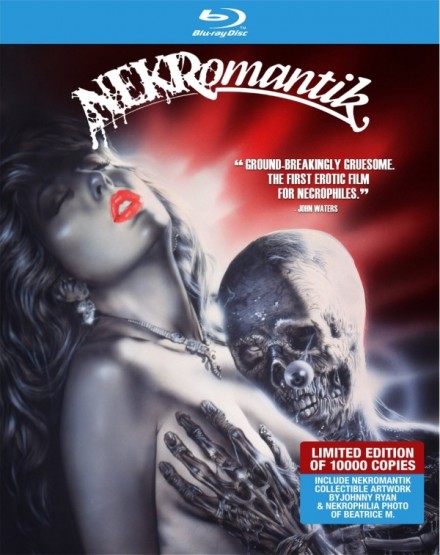
If one chooses to view Nekromantik as an allegory, it becomes easy to see how necrophilia could be interpreted as a means to address the manner in which individuals within a given society relate to the past. The film clearly shows how some people bury the dead and move on, while others have skeletons in the closet that they are unable to do away with. If a country chooses to forget a period of its history, then it stands to reason that individuals within that society will lose some degree of their perspective on how they arrived in their current situation, and may well be unaware of how the journey has affected them. With this in mind, we can posit that Robert feels compelled to bring souvenirs home from work because he is incapable of knowing who he really is, and that he receives some degree of perspective from these morbid reminders. The bones and body parts that decorate his dingy apartment allow him to know that he is alive, that he is not dead, and in doing this, they provide him with some measure of identity. As Marshall McLuhan explains “this meaningless slaying around our streets is the work of people who have lost all identity and who have to kill in order to know if they’re real or if the other guy is real.” 4
The anachronistic world in Kissed also appears to use necrophilia on a metaphoric level, although it goes in a much different direction. Sandra Larson’s necrophilia differs greatly from that which is depicted in Nekromantik, not just in visual presentation, but also in narrative terms. The dead are controlled and possessed by the characters in Buttgereit’s film, whereas Stopkewich’s protagonist seeks to act as a helping hand that allows for her cadaver conquests to ‘cross over.’ Sandra describes this experience as an explosion of light. This allows the audience to infer that her interaction with the corpses allows her to straddle the line which separates life and death, enabling her to coax the stubborn spirit out of the body via her physical contact. In this regard, the pleasure she receives is related to a sense that she is providing a measure of compassionate closure for the bodies that pass beneath her body, before they are buried under earth.
Additionally, her living lover Matt (Peter Outerbridge), while he does not commit physical acts of necrophilia, suffers from an unhealthy attachment to his past. The apartment that he inhabits is littered with old movie posters, textbooks from abandoned academic pursuits, and retro curtains in the doorways. He is stalled at a crossroads in his life, and is unsure of how to move forward. Sandra confessed her necrophilic tendencies to him before their relationship truly began, but he begins to perceive these acts as a threat. As their relationship breaks down he becomes increasingly clingy and needy. He starts keeping a log of her activities, and even confronts her with a copy of the obituaries, demanding to know which of the listings afforded her the opportunity to be unfaithful to him. These actions only serve to generate a further dissolution of their romantic entanglement. Despite the fact that they obviously have strong feelings for each other, there is the sense that they are simultaneously holding on and drifting apart. They both crave a solution, but remain ensnared by the binding nature of their emotions.
Both Robert and Matt are deeply affected when their lover is absent, and to a great extent Nekromantik and Kissed both embrace aspects of Laura Mulvey’s famed article “Visual Pleasure and Narrative Cinema.” Mulvey’s assertion that a woman’s “visual presence tends to work against the development of a story line” 5 is put on display in Nekromantik, as the departure of Betty marks the turning point in Robert’s life. Equally important though is the fact that Wood and Mulvey both address the idea that female characters are generally seen as passive. The way that Betty and Sandra indulge in intercourse with male corpses in both films allows for each woman to engage in sexual activity with a partner that is unable to subject her to his gaze. This is particularly true in Kissed where Sandra Larson makes a point of there being a division between the animate and inanimate hemispheres of her sex life. Matt’s insecurity is linked to his wholesale exclusion from such an important part of Sandra’s life. In Nekromantik, Buttgereit extrapolates upon this idea by having Betty take the corpse and leave the film’s narrative. This action allows her to completely escape the gaze of the camera and the audience, as well as that of her partner, Robert.
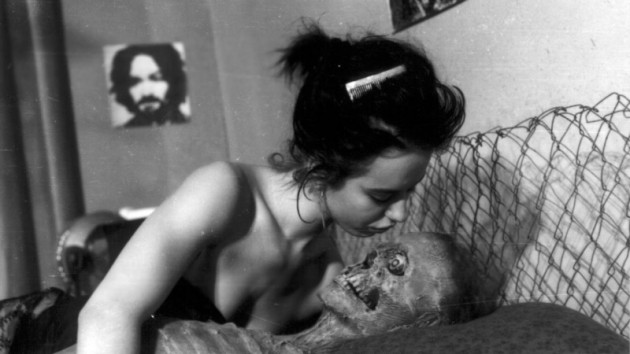
Betty’s rejection pushes Robert headlong into a crisis, and in Kissed, Sandra’s boyfriend Matt suffers a similar fate due to his jealousy of the time she spends with her other lovers. In both films the living male partner is made to feel emasculated when it is revealed that his girlfriend would rather be pleasured by a corpse than spend the night in his bed. This leads to an escalating loss of confidence, which ultimately results in a complete and utter inability for the two men to relate to their present environments. When Nekromantik’s Betty takes their deceased playmate and leaves the recently unemployed Robert, he is thrown into a tailspin of despair. He goes to the movies, but they no longer hold his interest, and when he resorts to seeking the services of a prostitute, even taking her to the graveyard isn’t enough to inspire his ardor. His only recourse is to strangle the unfortunate woman and then violate her dead body.
Matt’s path in Kissed is less extreme. He tries desperately to understand Sandra’s fascination, but is unable to suppress his jealousy. His insecurity brings him closer and closer to the fringes of sanity. Both cases correspond to McLuhan’s belief that “pornography and violence are by-products of societies in which private identity has been scrubbed or destroyed.” 6

Bibliography
Wood, Robin. “An Introduction to the American Horror Film.” The American Nightmare. Eds, Robin Wood and Richard Lippe. Toronto: The Festival of Festivals, 1979.
Wiater, Stanley. “Disturbo 13: The Most Disturbing Horror Films Ever Made” Cut! Horror Writers On Horror Film. Ed, Christopher Golden. New York: Berkley Publishing Group, 1992.
Hays, Matthew. “Doing the Dead.” Montreal Mirror. 27 March 2009.
Sharett, Christopher. “The Idea of the Apocalypse in The Texas Chainsaw Massacre.” Planks of Reason. Ed. Barry K. Grant and Christopher Sharret. 2004: p. 311.
McLuhan, Marshall. Forward Through the Rearview Mirror: Reflections On and By Marshall McLuhan. Eds, Paul Benedetti and Nancy DeHart. Scarborough, On: Prentice Hall, 1996.
Mulvey, Laura. “Visual Pleasure and Narrative Cinema.” 24 Screen 16.3 Autumn 1975: 6-18.
Notes
- Wood, Robin. “An Introduction to the American Horror Film.” The American Nightmare. Eds, Robin Wood and Richard Lippe. Toronto: The Festival of Festivals, 1979. p. 21 (course pack p.63). ↩
- Wiater, Stanley. “Disturbo 13: The Most Disturbing Horror Films Ever Made” Cut! Horror Writers On Horror Film. Ed, Christopher Golden. New York: Berkley Publishing Group, 1992. p. 262. ↩
- Sharett, Christopher. “The Idea of the Apocalypse in The Texas Chainsaw Massacre.” Planks of Reason. Ed. Barry K. Grant and Christopher Sharett. 2004: p. 311. ↩
- McLuhan, Marshall. Forward Through the Rearview Mirror: Reflections On and By Marshall McLuhan. Eds, Paul Benedetti and Nancy DeHart. Scarborough, On: Prentice Hall, 1996. p. 87. ↩
- http://www.composingdigitalmedia.org/f15_mca/mca_reads/mulvey.pdf. ↩
- McLuhan, Marshall. Forward Through the Rearview Mirror: Reflections On and By Marshall McLuhan. Eds, Paul Benedetti and Nancy DeHart. Scarborough, On: Prentice Hall, 1996. p. 75. ↩




